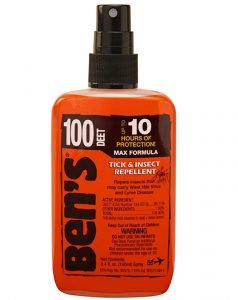I hate ticks. And I doubt I’m in the minority. In my area, ticks are everywhere, from the little deer ticks to the annoying lone star ticks to the large blacklegged ticks that end up attaching themselves to livestock. Ticks carry diseases, cause skin irritations, and are — simply put — a pain to have around. So finding options for some of the best tick prevention methods, especially on farms and in other rural areas, is important.
The swath of America where tick species thrive is so large it’s fair to remind everyone with animals and the potential for outdoors activities. Warmer, wetter weather throughout the country is the time of year to be particularly concerned, although people who work with animals indoors and inside barns would be best advised to be on the lookout every day.
Numerous tick and bug repellant are available on the market. The U.S Centers for Disease Control and Prevention advises people use a repellant containing 20 percent or more of DEET, or IR3535, on exposed skin, though picaridin is also gaining popularity as some research has shown it to be as effective as DEET. Follow product instructions and avoid direct contact with eyes and mouth.
There are a couple of other common-sense ways to prevent ticks, such as long pants and long-sleeved shirts, tall socks, and Wellington-style boots (the tall ones, whether leather or neoprene).
» Related: Ticks: Diseases and prevention of this appalling arachnid
The CDC’s list of potential tick-borne diseases and symptoms reads like a mini horror story. Most people are familiar with Colorado tick fever and Lyme disease, but other lesser known illnesses among the dozen-plus include Heartland virus and Ehrlichiosis. Cropping up more commonly these days is the alpha-gal allergy, which prevents those afflicted from eating any kind of mammal meat, as well as often limiting consumption of dairy products like milk and cheese.
Unfortunately, the signs and symptoms of a tick bite might take a while to recognize. The symptoms can range from mild to severe and could require hospitalization. Early recognition and treatment is always the preferred method and many of the symptoms are clear if you’re on the look-out.
When checking oneself for ticks, the use of a mirror is helpful to look on your body’s backside. Try to shower with hot water as soon as possible, and be sure to check under your arms, in and around ears, inside your belly button, behind the knees and legs, as well as in your hair. Keep in mind that ticks travel and can get trapped inside clothing and other gear. Make sure to wash clothing in hot water as it can kill the ticks. Tumble dry clothes in a dryer on high heat for at least 10 minutes as an added measure.
So, what are the best products to prevent ticks? Here are four of our favorites to keep these little critters at bay:
Tender Ben’s 100% DEET Insect Repellent
Probably my favorite on this list — and the one that has been most effective around my property. Ben’s 100 MAX Tick & Insect Repellent contains the maximum amount of DEET for use in areas of high bug density with intense biting activity. It provides up to 10 hours of protection from ticks and many other insects.
Sawyer Permethrin Insect Repellent
This is a great go-to spray, and it’s often used by many folks in the outdoor industry. Sawyer bills this picaridin 20 percent spray as not just repelling insects, but actually killing mosquitoes, ticks, chiggers, mites, and more than 55 other kinds of insects on contact. It’s odorless after drying, and a single application lasts up to six weeks or through six washings (whichever comes first) of sun exposure.
Ranger Ready Tick & Insect Repellent
Another picaridin 20 percent insect repellent, it is orange-scented and will not stain or damage clothing, fabrics, plastics, or finished surfaces. Though I haven’t tested its full capabilities, it reportedly provides 12 hours of protection from ticks, and eight hours or more from many other insects you may encounter on the farm.
LYMEEZ 3D Mesh Leg Gaiters
I’ve been using these for a couple of years now, and they’re especially good to have in my truck or otherwise accessible for those times I’m not wearing my 14-inch tall LaCrosse boots. They’re super easy to put on, and they work effectively as ticks are unable to easily climb the mesh material that the gaiters are made of, plus they have a microencapsulated permethrin further keeping ticks at bay. According to the company, “Ticks instinctively explore the variable-sized mesh holes — diverting and slowing them on their climb.”
They’re particularly handy if you don’t feel like spraying yourself down with something.
We are committed to finding, researching, and recommending the best products. We earn commissions from purchases you make using the retail links in our product reviews. Learn more about how this works.
(function(d, s, id) {
var js, fjs = d.getElementsByTagName(s)[0];
if (d.getElementById(id)) return;
js = d.createElement(s); js.id = id;
js.src = “//connect.facebook.net/en_US/sdk.js#xfbml=1&version=v2.8&appId=320025038337187”;
fjs.parentNode.insertBefore(js, fjs);
}(document, ‘script’, ‘facebook-jssdk’));
Source link
















